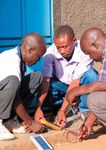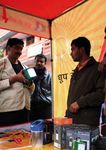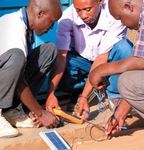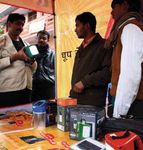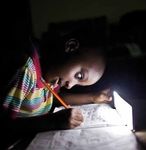ENERGIZE THE BOP! ENERGY BUSINESS MODEL GENERATOR FOR LOW-INCOME MARKETS - CHRISTINA GRADL AND CLAUDIA KNOBLOCH
←
→
Page content transcription
If your browser does not render page correctly, please read the page content below
Christina Gradl and Claudia Knobloch
Energize
the BoP!
Energy Business Model Generator
for Low-Income MarketsE n e r gi z e t h e B o P !
Acknowledgements
The authors would like to thank
everyone who contributed to
this publication.
Partners Experts
We would like to extend a special thanks to our partners: Experts on inclusive energy issues from consultancies, academia
and organisations active in the field contributed to this publica-
The German Federal Ministry for Economic Cooperation and tion with their feedback and by sharing their experience in inter-
Development (BMZ, Bundesministerium für wirtschaftliche views. We are grateful to:
Zusammenarbeit und Entwicklung) and E.ON Energie AG pro-
vided their expertise and financing for this publication. Delphine Bazalgette, PlaNet Finance Deutschland e.V.
Barbara Börner, Canopus Foundation
MicroEnergy International, together with Endeva, brought this Dr. Anil Cabraal, Consultant
project to life and throughout the process has contributed their Dr. Nicolas Chevrollier, BoP Innovation Centre
extensive know-how in providing energy services to low-income Shantanu Dixit, Prayas Energy Group
people. Mauro Fadda, E.ON Climate & Renewables
Lisa Feldmann, GIZ Poverty-Oriented Basic Energy Services
The Wittenberg Center for Global Ethics and the Vattenfall- Programme (HERA)
Europe Endowment Chair Energy Management and Sustain- Christian Friebe, European Business School
ability contributed advice in setting up this project. Jennye Greene, E + Co
Mark Hankins, African Solar Designs (K) Ltd.
Lars Holstenkamp, Leuphana University of Lüneburg
Academic panel Oliver Karius, LGT Venture Philanthropy
Several academic experts contributed their time and expertise to Jim L. Koch, PhD, Santa Clara University
the development of this publication. We are grateful to: Stefan Koch, E.ON Energie AG
Guido Konijnendijk, Consultant
Rahul Barua, VU University Amsterdam Diana Kraft, GIZ
Christoph Birkholz, University St. Gallen Saurabh Lall, World Resources Institute
Nicola Ursina Blum, ETH Zurich Laurent Liautaud, Hystra
Noara Kebir, University of Luxembourg Matthew Lynch, WBCSD
Dr. Malte Schneider, ETH Zurich Matthew McDermott, GIZ
Ronald Venn, University of Hamburg Jonas Naguib, GIZ
Filippo Veglio, WBCSD
Research support
We are also indebted to our talented Endeva research associates
who have made possible the collection and evaluation of the
massive amount of research informing this report.
Katharina Kaesehage
Judith Mayer
Alyssa Rivera
Supported by:Energize
the BoP!
Energy Business Model Generator
for Low-Income Markets
Christina Gradl and
Claudia KnoblochE n e r gi z e t h e B o P !
WHY VENTURE INTO THE
LOW-INCOME MARKET? 8 HOW DO WE DO BUSINESS WITH
LOW-INCOME CUSTOMERS? 18
WHAT RESOURCES ARE REQUIRED
TO DEVELOP A BUSINESS? 30 WHERE DO WE FIND
SUPPORT? 42Content
Business Case List of case STUDIES
WHY VENTURE INTO THE LOW-INCOME MARKET? . ....................................... 8
User needs ............................................................................................................................... 10 SKG Sangha, India
Market development ........................................................................................................ 11 page 23
Market size .............................................................................................................................. 12
Connection types and technologies ....................................................................... 13 La Electricidad de Caracas (EDC), Venezuela
The state’s role ...................................................................................................................... 14 page 25
Partners . ................................................................................................................................... 15
Business model .................................................................................................................... 16 Temasol, Morrocco
page 27
Customer Interface
HOW DO WE DO BUSINESS WITH LOW-INCOME CUSTOMERS? ........... 18 Sunlabob, Laos
How it works .......................................................................................................................... 19 page 29
General challenges and solutions ............................................................................ 20
Sales ............................................................................................................................................ 22 Bosch und Siemens Hausgeräte GmbH
Payment .................................................................................................................................... 24 (BSH), Philippines
Service . ...................................................................................................................................... 26 page 33
End of product use ............................................................................................................. 28
d.light design, Africa & Asia
Development Process page 35
WHAT RESOURCES ARE REQUIRED TO DEVELOP A BUSINESS? . ......... 30
How it works .......................................................................................................................... 31 Électricité de France SA (EDF), Mali
Product ...................................................................................................................................... 32 page 37
Market insight . ..................................................................................................................... 34
Human resources ................................................................................................................ 36 Selco, India
Finance ...................................................................................................................................... 38 page 39
Support Directory
WHERE DO WE FIND SUPPORT? ............................................................................... 42
Product design ..................................................................................................................... 44 Spotlight
Market insight . ..................................................................................................................... 44
Financing ................................................................................................................................. 44 Accessing the carbon market
Carbon market ...................................................................................................................... 45 page 40
Platforms . ................................................................................................................................ 45
Further reading .................................................................................................................... 46 develoPPP.de — Development
Acronyms ................................................................................................................................. 47 partnerships with the private sector
Endnotes .................................................................................................................................. 47 page 41
Approach .................................................................................................................................. 48
About Endeva ........................................................................................................................ 50
About the “Energize the BoP” training .................................................................. 50
Publication information ................................................................................................. 51E n e r gi z e t h e B o P !
6| 7
Photo: Susanne Ullerich
At least 250 businesses have already been established to provide We are not alone in our passion for enabling energy businesses.
energy services for consumers at the base of the global income As soon as we established this project, researchers and organisa-
pyramid (or “BoP”). In fact, many more probably exist, as these tions began approaching us, asking to be part of it. Others joined
are simply the documented cases we have found in the course of at our request. The long list of acknowledgements impressively
our “Energize the BoP” research. But if this is true, how is it pos- illustrates this enthusiasm. We thank every one of these partners
sible that 1.4 billion people still lack access to electricity? Why for contributing their experience, financial resources and time.
have so few of these businesses grown to a larger scale?
The product of these combined efforts is a very practical guide.
The reason, and the impetus for this guide, is that most business- It is aimed at practitioners who target low-income consumers to-
es targeting the BoP do not have a sustainable business model. day, or who plan to move in this direction. The content should
We see the same mistakes being made over and over again. Too prove useful for companies of all sizes and backgrounds, from
many of these ventures set off to enter the market with rushed, the start-up to the large utility, from companies offering grid con-
little or even no market research and fail to consider how sales nections or mini-grids to those selling off-grid appliances such as
and service processes can support their technology. Too many lamps or stoves.
also fail to consider the kind of human resources needed to grow
their business in local contexts. Nevertheless, we absolutely be- Like any reliable guide, the generator covers the most important
lieve in the power of business to energize the BoP. This guide is in- factors to consider. However, because the BoP energy market
tended to strengthen this power by supporting entrepreneurs in is an emerging market, this guide is necessarily incomplete. As
taking the right steps toward doing sustainable business in the companies continue to innovate and experiment, we continue
BoP. It is conceived as a business model generator for those ad- to learn. We therefore encourage all readers to add to the know
dressing the BoP’s energy market in particular. Drawing upon the ledge presented here by sharing your experiences with us via
documented experiences of 250 businesses, 35 of which we have email. Your narratives will not only be integrated into our training
analysed in depth, the generator is divided into four chapters: programme, but will help shape the future of energy business at
the BoP.
Business Case presents the rationale for venturing into the
low-income market. Sincerely,
Customer Interface shows how to interact with low-income
customers.
Development Process provides advice on starting, implement-
ing and growing a business.
Support Directory collects useful contacts and links. Christina Gradl and Claudia Knobloch
c.gradl@endeva.org c.knobloch@endeva.orgForewords
Andreas Pohlmann/E.ON
Photo: BMZ
Photo:
Dear Entrepreneurs, Energy markets around the world face enormous challenges.
As you can tell from its name, the Federal Ministry for Economic Providing climate-friendly and affordable energy are the calls to
Cooperation and Development (BMZ) considers economic co-op- action. The energy industry bears a particular responsibility to
eration an integral component of development policy. include within these markets the millions of people worldwide
living at the base of the pyramid (BoP).
There can be no sustainable development without sustainable
economic development. We therefore recognise the business The energy sector can promote sustainable development in
sector as an essential partner. Companies develop products and these markets by applying smart technologies and better busi-
services that enhance the quality of life for millions of people ness models. We can also deepen our know-how by learning from
every day. However, low-income populations in developing and the needs and constraints of people living at the BoP. This drives
emerging economies often have no access to these products and innovation in developing products and services attuned to these
services. When it comes to energy, 1.4 billion people worldwide markets.
lack access to electricity and an even larger number rely on tra-
ditional biomass to cook and heat their homes. Inclusive busi- As an international provider of energy solutions, E.ON draws upon
ness models can produce innovative solutions that provide low- a broad range of experience and technical expertise in the areas
income households with access to energy in cost-efficient, safe of energy generation and supply. This study addresses further
and sustainable ways, while creating opportunities to scale-up important issues regarding markets in developing and emerging
value chains in our partner countries. For entrepreneurs doing economies. At the same time, it provides E.ON with valuable in-
business in demanding environments, the challenges are great, sights and practical recommendations. As a practitioners’ guide,
but not insurmountable. this publication helps us evaluate the introduction of our compe-
tencies into new markets — responsibly and sustainably.
This publication guides you through the business model devel-
opment process and offers practical advice. Creative solutions E.ON is committed to providing cleaner and better energy for all
already under way by companies successfully serving base of markets now and in future. The goal is to promote viable busi-
the pyramid customers are showcased here. We hope that these nesses that create a win-win situation. Sound energy solutions
examples and the information provided here will support and should expand the scope of opportunities for the people at the
inspire you to create and implement inclusive energy business base of the pyramid as well as the companies involved.
models that benefit you and your customers.
Energizing the BoP also means energizing the future. This is a fu-
ture we aim to shape sustainably.
Hans-Jürgen Beerfeltz
State Secretary
Prof. Dr. Klaus-Dieter Maubach
Federal Ministry for Economic Cooperation and Development (BMZ)
Member of the Board of Management E.ON AG
Research & Development, New Build & Technology,
Corporate Responsibility, Health/Safety & EnvironmentE n e r gi z e t h e B o P !
8| 9
Business
Case
With his lamp from Philips Lighting, this
young student can do his homework after
sunset — without exposing himself to the
pollutants generated by kerosene lamps.
Photo: PhilipsWHY VENTURE
INTO THE LOW-INCOME MARKET?
1.4 billion people around the world lack access to electricity, while 2.7 billion people cook with traditional biomass.
This “energy poverty” hinders economic and social development.
The 4 billion people living on less than $3,000 per year spend $433 billion per year on energy.
Technical solutions providing clean, affordable and reliable energy services to this target group already exist.
Leapfrogging is possible.
Developing sustainable business models is the key to entering low-income markets.
Established
Markets
LOW-INCOME
Markets
2.7 billion people cook and heat with
traditional biomass
1.4 billion people do not have access to
electricityB usi n ess C ase
10 | 11
User needs: 1.4 billion without access to electricity
Access to clean, affordable and reliable energy is a fundamental The traditional use of biomass and petroleum-based fuels carries
driver of economic growth, environmental sustainability and a number of serious disadvantages:
social development. Just as farmers need pumps to irrigate their
fields, and workshops need energy to power machines, service Fumes from indoor fires cause health problems. The World
providers require computers and telecommunication devices in Health Organisation estimates that every year nearly 2 million
order to provide modern services. Hospitals, too, need energy to people die from diseases related to indoor smoke — mainly
keep vaccines cool and run modern operating rooms. Energy also children and woman who prepare meals.3
fuels the future by allowing students to study into the night with
proper lighting. TVs and radios inform and entertain, while mod- In addition to health problems, collecting wood consumes
ern domestic devices such as refrigerators and stoves reduce time that could be used productively or for educational pur-
women’s burdens and help raise standards of living. poses. Girls and women all over the developing world spend
hours each day collecting firewood.
Nevertheless, billions of people lack access to clean, affordable
and reliable energy: 1.4 billion have no access to electricity and Unsustainable harvesting of wood and other biomass acceler-
must rely on candles or kerosene for light and diesel for produc- ates deforestation, causing a loss of biodiversity and absorp-
tive uses. The lowest electrification rate is found in sub-Saharan tive capacity for CO2. Black carbon from incomplete combus-
Africa, where only 31% of the population has access to electric- tion of fossil fuels or biomass also contributes to climate
ity. Around 76 million people in Nigeria and 68 million in Ethiopia change.4
lack connection to energy supplies. Around the world, 2.7 billion
people cook on traditional three-stone fires using wood or dung. Energy from kerosene or candles is much more expensive than
Most live in rural regions of emerging and developing countries.2 electricity from the grid; the disadvantaged pay expensive
rates for low-quality services. The high cost hinders economic
productivity.
In many countries, the public sector is unable to provide energy
services to low-income households. The extension of power grids
to remote areas can be financially untenable due to low popu-
lation density and low consumption levels. Private companies
therefore play an important role — often in collaboration with
other stakeholders such as NGOs and governments — in serving
the needs of the “unconnected”.
Figure 1 Figure 2
People without access to electricity People relying on the traditional use of biomass for cooking
(in millions, 2009) (in millions, 2009)
Latin America 31 Latin America 85
Africa 657
Other Asian
Other Asian
countries
countries
659
387
Africa 587
Total Total
1.4 billion 2.7 billion
China 423
China 8
India 404 India 855
Source: IEA/OECD (2010) Energy Poverty Source: IEA/OECD (2010) Energy PovertyE n e r gi z e t h e B o P !
Market development: rising populations, growing political support
The global energy market at the base of the economic pyramid is Governments in developing countries are waking to the poten-
already vast, and will grow further in the decades to come. tial of private energy services for this target group. The Indian
government, for example, established a national goal for univer-
The global population is increasing at a high rate. From today’s sal access to energy with its Rural Electrification Policy in 2006.
almost 7 billion people (2011), it will rise to more than 9 billion in In order to achieve this aim, it created a number of new financing
2050, the UN estimates. Virtually all of this growth will take place arrangements, including subsidies for the installation of renew-
in emerging and developing countries, outside the OECD.5 The able energy plants.
global urban population will double as cities experience a dis-
proportionate share of this population increase.6 Small and large companies are responding to the demand. How-
ever, most of the business-driven energy projects at the base of
According to the New Policies Scenario of the International En- the global income pyramid have yet to gain significant scale.
ergy Agency, 1.2 billion people in 2030 will still lack access to elec- The landscape of players is diverse, ranging from multinational
tricity.7 The global electrification rate will rise from 79% in 2009 to companies and large utilities to small and medium-sized renew-
85% by 2030 — but with profound regional differences. Whereas able energy companies, to social entrepreneurs from developing
China will reach universal electrification, only 50% of people liv- countries, to spin-offs from design centres at universities.
ing in sub-Saharan Africa will have access to electricity. In abso-
lute numbers, around 650 million Africans will be without access
to electricity.8 Innovative approaches will be required to close
this gap. Taken together, these figures show there is a huge and
growing potential market for companies that supply clean, af-
fordable and reliable energy services to low-income households. Figure 4
World population without access to energy,
2009 and 2030 544
(in millions) 108
Figure 3
■ Rural 465
Population growth, 1950—2050 ■ Urban 120 381
(in millions) 23
281
328
10,000 12
59
■ Urban – less developed
9,000 0 0
■ Rural – less developed 8 0
■ Urban – more developed 8,000
2009 2030
■ Rural – more developed 212
7,000 China 40
6,000
27
5,000 4 8
2
4,000
2009 2030
3,000 2009 2030
Latin America
India
2,000
1,000 2009 2030
Other
2009 2030
developing
1950 1960 1970 1980 1990 2000 2010 2020 2030 2040 2050
SUB-SAHARAN Asia
AFRICA
Source: UN Population Division (2008) World Population Prospects: The 2008 Revision Source: IEA/OECD (2010) Energy PovertyB usi n ess C ase
12 | 13
Market size: almost half a trillion dollars
Most people without access to electricity live in poor parts of In some countries, the BoP comprises the largest share of the en-
emerging and developing countries, in slums and rural areas. The ergy market. It accounts for 90% of spending on non-commercial
4 billion people that live on less than $8 per day (adjusted for lo- energy in countries such as Indonesia and Nigeria, and more than
cal purchasing power parity) spend an estimated $433 billion on 50% in countries such as Brazil, India and Uganda.10
energy per year, according to IFC and WRI estimates. These “Next
4 Billion” make up the base of the global income pyramid, or the A common phenomenon in low-income markets is the “poverty
“BoP”. The largest regional market is Asia (including the Middle penalty”. This refers to the fact that poor people have to spend
East), with annual spending estimated at $351 billion among a more than wealthier ones on the same product or service. A
total of 2.9 billion people. study performed by MicroEnergy International showed that 1
kWh costs $2.30 in rural Bangladesh, compared to about $0.30 in
Next to food and housing, energy is the biggest expense for low- Western Europe.11 The cost of lighting can also be much higher,
income households. An average 9% of the overall BoP household as shown in a report from Guatemala for 2000. In that year, 1 kWh
expenditure is spent on energy. Households with an annual in- of light cost $0.08 from the grid, $5.87 from kerosene and $13.00
come of up to $500 spend an average of $148 per year on energy, from candles.12 People in these contexts are therefore well pre-
equivalent to around $0.40 a day. Those earning between $1,000 pared to pay affordable sums for clean, reliable energy services.
and $1,500 per year spend nearly $1 a day. These per-customer
amounts are comparatively small, but in sum they represent a Most energy-related expenditure is focused on cooking, heating
market of significant size.9 and lighting. While energy for cooking and heating is often pro-
vided through the traditional use of biomass, such as wood or
charcoal, low-income households generally use paraffin candles
and kerosene lamps for light. Spending is very flexible for all of
these fuels, as products and services may be purchased in micro-
amounts. As BoP incomes are not only low, but typically also ir-
regular, low-income consumers tend to value this flexibility. This
“competitive advantage” is worth considering when developing
pricing models for inclusive energy businesses.
Figure 5
Energy expenditures of those with Figure 6
annual incomes below $3,000 Cost of 1 kWh electricity 2.30 $
¢
(in billion $ PPP, 2006) (in $)
¢ ¢
¢ ¢
¢ ¢
¢ ¢
Africa 26.6
¢ ¢
¢ ¢
Total Eastern Europe 25.4
Asia 350.9 ¢ ¢
$433 billion
¢ ¢
Latin America 30.5
¢ ¢
0.30 $
¢ ¢ ¢
¢ ¢ ¢ ¢
Germany Bangladesh
Source: WRI/IFC (2007) The Next 4 Billion. Source: MicroEnergy InternationalE n e r gi z e t h e B o P !
Connection types and technologies: on the grid, off the grid and mini-grids
Companies use a variety of technologies to provide low-income Off-grid systems and appliances: In some cases, mini-grids
households with clean and affordable energy. With regard to the cannot be operated profitably in rural areas due to the small
business model, the connection type is more important than the number of potential customers, geographical constraints
way the energy is produced, as it defines how the company will or the income structure of the community. Off-grid systems
interact with the customer. can play a key role in these contexts. Such systems (or “appli-
ances”) provide a single household with energy. For example,
Grid connection: For households, public community facili- solar home systems installed on hut rooftops can provide
ties or local small business that are reasonably close to exist- enough energy for lamps and for charging mobile phones. In
ing transmission and distribution lines, getting connected to other cases, solar-powered lamps can provide lighting, and
the grid may be the best and most economical option. Users improved cookstoves powered by gas or oil can make smoke-
typically pay a one-off fee for the initial grid connection, and free meals possible. These products are frequently produced
thereafter a monthly service fee based on the electricity they locally and sold by the producers themselves, or through sales
use. Providers of such services have generally been existing agents or local retailers that often also provide post-purchase
utilities in developing countries. In South Africa for example, service and ensure the collection of payments. The market for
ESKOM has connected 3.8 million households to the grid since off-grid systems and appliances is quite diverse, attracting at-
1991.13 These electricity providers often find innovative ways tention from established multinational corporations (MNCs)
to collect payment, introducing items such as pre-paid cards such as Philips and Shell and informal entrepreneurs alike.
or collective meters for an entire neighbourhood. Many utilise
social networks to increase the financial sustainability of their Although the connection types presented here require very dif-
efforts, for example by partnering with existing co-operatives ferent business models and customer approaches, inclusive en-
or community organisations to organise connections on a lo- ergy enterprises encounter many similar issues and solutions
cal level. along the way. The insights collected in the chapters “Customer
Interface” and “Development Process” can therefore inform the
Mini-grids: Remote villages can be electrified by setting up activities of a broad range of inclusive energy providers.
small power plants that provide enough energy for the vil-
lage’s household and productive needs. Mini-grids are usually
run either by a local entrepreneur or a village co-operative, but
larger companies can also find a business case here. French
energy provider EDF developed two mini-grids in Mali in part-
nership with a leading Dutch energy company, NUON. The
technologies used to generate the power range from biomass/
biogas to hydro to solar energy, or in some cases, a combina-
tion of different sources or the application of hybrid systems (a
combination of technologies). Renewable energy sources are
often backed up by a diesel generator in order to ensure a 24/7
energy supply.B usi n ess C ase
14 | 15
The state’s role: providing access, security and incentives
Energy is heavily regulated and subsidised around the world. Government action supports private investment in energy pro-
Governments have a vital interest in securing universal energy vision in three different ways: by providing market access, in-
provision, because it is a prerequisite for economic growth, so- creasing investment security and offering direct incentives for
cial development and equality. For this reason, energy genera- investment. Private companies will only develop business on a
tion and distribution was for many years monopolised by pub- large scale if these factors collectively contribute to creating a
lic companies. Indeed, many of today’s energy utilities are still welcoming, business-friendly environment. Each is examined in
public companies or have only been recently privatised. Govern- more detail below.
ments and national regulations continue to play a crucial role in
the setting up of an energy business. Market access: Unhindered access to energy markets is a
prerequisite for all companies in the energy sector, not only
Particularly in developing countries, where access to energy is to those serving low-income markets. This is true both for
not universal, governments often set up policies that provide in- domestic and foreign companies. Governments need to open
centives for the private sector to invest in electrification of rural up energy markets to private investors in order to allow com-
areas and slums. For example, India’s Rural Electrification Policy petition and attract foreign direct investment. Public private
of 2006 established a national goal for universal access, assigned partnerships (PPPs), where the state contracts the provision of
responsibilities for implementation and created new financing services out to private companies, have been frequently used
arrangements that benefited the private sector. as a mode of market access.
Another driver of regulation is the need to comply with interna- Security: Private companies need to be able to calculate and
tional limits on CO2 emissions. This is an important motivation manage risks. Investors seek political stability and reliable,
in emerging economies such as China or India, whose economic long-term regulation on issues such as feed-in tariffs. The se-
growth has led to a fast-increasing demand for energy. In these curity of their investments with respect to events such as the
cases, factories and the middle class are the largest contributors nationalisation of companies is also a crucial concern.
to emissions and can therefore have the largest impact in mini-
mising emissions. However, people that are not yet connected to Incentives: Subsidies in the form of grants, interest-free loans
the grid can “leapfrog” to the use of environmentally friendly en- or tax holidays for rural electrification and clean energy pro-
ergy sources. This idea is supported by many of the international vision support business models that might not otherwise be
public organisations and donors that support governments in profitable from the start, especially where they require large
developing countries in creating an environment supportive of levels of investment. The promotion of climate-friendly energy
renewable energy use. solutions is supported through national, regional and global
carbon markets such as the Clean Development Mechanism
There are several useful tools in existence that help companies (CDM) under the UN Kyoto Protocol.
find their way through the multitude of policies. For example, the
global policy network REN21 offers an overview of energy poli- In addition to introducing policies addressing energy provision
cies, with a focus on renewable energy all around the globe.14 directly, governments can improve the general business envi-
ronment for companies by enhancing infrastructure, cultivating
knowledge and skills among the population, and facilitating ac-
cess to formal markets for low-income people.E n e r gi z e t h e B o P !
Partners: combining capabilities, magnifying success
To reach low-income communities, businesses typically work Microfinance institutions (MFIs): MFIs offer loans ranging
with partners. Often enough, even domestic companies from de- from $10 to $1,000, without asking for collateral in the manner
veloping countries do not have extensive experience doing busi- of a conventional bank. One of the classic models is the group
ness with people in poverty in an environment that lacks basic loan, where a group of borrowers bears collective responsibil-
infrastructure, financial services and consumer literacy. NGOs, ity for the credit. Individual lending models also exist. Borrow-
microfinance institutions (MFIs) or co-operatives are usually the ers include women who ideally invest the money in starting a
partners of choice because they frequently maintain operations small business or in improving the productivity of their farm.
on the ground and have strong local networks that reach out to MFIs play an important role in financing all kinds of invest-
people in poverty. ments in slums and rural areas.
Non-governmental organisation (NGOs): NGOs are mission- Some MFIs have discovered energy solutions as a new stream
driven organisations aiming to achieve social or ecological of revenues, and as a way to support their own customers’ gen-
objectives. Many humanitarian and environmental NGOs in eration of income. MFIs can introduce stoves, lanterns or solar
developing countries are involved in the energy business be- home systems as complementary products into their portfolio,
cause it is so interlinked with topics such as health, education thus diversifying their business revenues.
and climate change.
Energy businesses often choose to partner with MFIs in order
By partnering with companies, NGOs may pursue long-term to provide their customers with easy access to credit to finance
viability and gain a much larger scale than would be possible high up-front investments such as an off-grid solar panel or a
without the economic power of the companies. They can pro- grid connection. Sometimes, MFIs take on other roles such as
vide their target groups with sustainable energy solutions that selling energy systems or providing after-sales service directly.
solve additional problems such as the prevalence of smoke-re-
lated diseases, or which grant people access to modern means Co-operatives: Co-operatives are organisations in which mem-
of communication. bers have come together for a common purpose such as the
purchase or sale of goods and services. Farmers’ co-operatives
Companies benefit from such collaboration because NGOs can are a widely used model in developing countries that facilitate
help carry out market research, to raise awareness of the ben- access to markets. Co-operatives usually ensure high and reli-
efits of modern energy solutions, assist with the distribution of able product quality by providing training and certification to
products, and train sales personnel.15 their members. These bodies are therefore often interested in
providing their members with ways to improve productivity.
Co-operatives play an interesting role in the energy sector in
two ways. On the one hand, they can be used as a partner for
the distribution and sale of solar home systems or appliances
such as lanterns. On the other hand, co-operatives can also be
formed to operate a mini-grid, or even to organise distribution
and payments for grid connections.B usi n ess C ase
16 | 17
Business model: a clear value proposition for all stakeholders
A business model describes how a business creates value. It de- Transactions with customers represent the most unusual chal-
picts how the firm interacts with the actors in its “ecosystem”, lenge associated with building a new business model in low-in-
including its customers, suppliers and business partners. More come markets. Customers are typically embedded in market en-
precisely, it defines the value proposition of the business to each vironments that are not only new for many businesses, but also
of these actors and how transactions with them are organised in difficult by many standards. The slums and villages in developing
order to align incentives. countries often lack the conditions that make business in more
developed markets smooth, efficient and economically viable. In
The heart of any successful business is a value proposition that developing countries, market information is scarce, physical in-
truly meets the needs and wants of its customers. Entrepreneurs frastructure such as roads are often poor, and legal frameworks
often build their business idea on a specific technology without and enforcement mechanisms are underdeveloped and unreli-
critically assessing if and how this technology can create value able. Furthermore, low-income customers in these areas lack in-
for customers, what their alternatives are, and by which crite- formation, and service providers able to organise anything from
ria they assess their alternatives. For example, many businesses financial transactions to logistics and retail may simply not ex-
have encountered reluctance among customers to purchase ist. In short, the cost of doing business in low-income markets is
clean cookstoves because of cultural preferences and traditions. typically high. At the same time, low-income households have a
Solar cookers also have no value for users who want to cook in very limited budget for spending on energy, and find it difficult
the evening when it is dark. A deep understanding of the prefer- to make high up-front investments due to the high cost of and
ences of one’s customers must therefore be the starting point for limited access to credit.
any business development.
A successful business model at the BoP must find innovative
ways to interact with its customers without spending more than
what the deal is worth. Therefore, the design and organisation
of the customer interface is the focus of the second chapter.
Four types of interactions are critical: sales, payments, service,
and end of product use. The energy businesses analysed in this
research have developed a number of promising solutions to
typical issues and can serve as an inspiration for other business
models.E n e r gi z e t h e B o P !
A business evolves over time. Even though the basic value prop-
osition may remain the same, processes need to be adapted as
the business grows in order to enable greater efficiency. It is not
always easy to have all the necessary resources for growth in
place at any one time, namely financing, human resources, mar-
ket insight and product. The third chapter therefore summarises
promising approaches for developing these resources from the
design phase to the implementation and growth phase. The
fourth chapter serves as a reference guide to the broad range of
organisations and practitioners with expertise in areas ranging
from finance to capacity building to designing business strate-
gies tailored to low-income markets.
Figure 7 :
Schematic overview of the business model generator
Value Proposition
Costumer
Market interface
Finance
Insight Chapter 2
Sales
Development
proCess
Chapter 3 Payment
Human Service
Resources Product
End of
Product Use
Sustainable business modelE n e r gi z e t h e B o P !
18 | 19
Customer
Interface
d.light sales representatives demonstrating
the solar lamp “Nova D.Light” at a stall in
Chamieyani, India. They explain the advan-
tages of the lamp to convince potential
customers of the product’s benefits.
Photo: The Ashden AwardsHow DO WE do business with
low-income customers?
Interactions with customers are focused on four main areas:
sales, payments, services and dealing with products at the end of their use.
Companies often struggle with challenges in the market environment, in particular with regard to information about the market,
regulatory burdens or complications, shortcomings in physical infrastructure, gaps in customers’ knowledge and skills, and the
limited access to financial services.
The generic strategies to address these problems include engaging in market research, providing customer service, ensuring local
representation, educating stakeholders and finding innovative financing solutions.
How it works
What most differentiates business in low-income markets from these ideas to their own ventures and use them to create a new
business in more upscale markets is the interaction with the cus- business model or improve on an existing model. The next two
tomer. Limited infrastructure, informal markets, a lack of financial pages summarise the general pattern of challenges and solutions,
services and other constraints increase transaction costs and which is later applied to each element in more detail.
limit the applicability of standard business models. The generator
therefore concentrates on businesses’ interfaces with their cus- For each element of their business model, readers of the genera-
tomers. How can you convince the customer of your product’s tor should ask themselves:
value if they have never heard of renewable energy? How can you
ensure payments when your customers lack access to a bank ac- What constraints do we face with our business?
count and have limited cash flow? How can you provide reliable
service when there is no customer support in place? And what Which of the solutions can we apply to our business, and which
happens with your product at the end of its lifetime? Is it reused, solutions address the constraints most effectively?
recycled or just thrown away?
Step by step, users can design a customer interface able to deal
This chapter identifies the main constraints businesses face in with typical issues in low-income markets. The four steps revolve
each of the four key customer interface areas sales, payment, ser- around the following main questions:
vice and end of product use. It also lists strategies and concrete
solutions that have proved successful. Practitioners can apply
Figure 8
Elements of the customer interface
How can we communicate the value of our
product to the customer?
Sales
Who sells our product, where and how?
How can our customers afford the product?
How can our customers best pay for Payment
the product?
How can we provide reliable service
at low cost?
SERVICE
How can we avoid waste and pollution?
How can we enhance the END OF
value of used products? PRODUCT USE
Source: EndevaC us t ome r I n t e r face
20 | 21 General …
Businesses face fundamental challenges in low-income markets and adopt broad
strategies in tackling these problems. These general challenges and solutions are
revisited throughout the sections on each of the four interface elements — sales,
payments, service and the end of product use. Understanding this pattern can help
practitioners develop their own innovative solutions.16
… Challenges …
Market information
Customer profile information is limited (from the perspective of preferences,
circumstances and spending patterns, for example).
Energy markets are highly regulated. Market environments and regulatory
processes often lack transparency, especially for foreign entrants.
Regulatory environment
People lack legal land titles, leading to contract and credit issues.
Due to previous bad experiences and a lack of formal protection,
customers often lack trust in newcomers.
Contracts with customers for continuous service are difficult to enforce
through formal processes.
A lack of security increases the risk of theft and damage to equipment.
Gaining official approval for installations (setting up small grid systems,
for example) can take considerable amounts of time.
Physical infrastructure
People in remote areas are hard to reach, which increases the cost of installing
and maintaining equipment (due to the lack of roads or phone connections,
for example).
Harsh natural environments can cause damage to equipment.
Skills and knowledge
Companies find it difficult to recruit and retain skilled staff.
Consumers lack awareness of products and services and their benefits.
Customers lack the skills to install, maintain or repair equipment.
Access to financial services
Customers find it difficult to obtain credit to finance high up-front costs.
Customers do not have access to bank accounts through which to
make payments.E n e r gi z e t h e B o P !
… a nd Solutions
Conduct market research
Conduct market research with standard and specialised methods at dif-
ferent times of the day and year (using tools such as home stays,
field trips, etc.).
Test the product with customers.
Build processes enabling continuous feedback from customers and staff.
Provide customer service
Regularly visit customers for maintenance.
Provide warranties (and be sure that you are able to fulfil the terms).
Organise payment collection so that it is convenient for customers.
Ensure local representation
Ensure local representation through existing local stores, the company’s
own subsidiaries or franchisees.
Provide a local supply of spare parts and fuels.
Divide service responsibilities between representatives and the com-
pany’s own staff.
Educate stakeholders
Educate and train customers, the company’s own staff and
local representatives.
Raise public awareness.
Involve and collaborate with local authorities.
Find innovative financing solutions
Adjust payment solutions to fit customers’ financial situations.
Provide customers with access to microcredit.
Facilitate income generation.
Apply for government subsidies.C us t ome r I n t e r face
22 | 23 Sales
In order to sell energy products to low-income households, sales staff must be ad-
ept at understanding customer needs and constraints, and able to explain the use
and benefits of the product. Businesses must have the capacity to reach out and
contract with customers, which involves building customer knowledge and sales
channels. Therefore, they often work with local communities and their authorities
as well as organisations that have trusted relationships with the target group.
Challenges …
Limited understanding of customer preferences
In the early phases of low-income market entry, businesses often lack knowledge
about the target group. Information about issues such as customer preferences,
user profiles and payment barriers are not readily available through convention-
al resources. Research institutions and consultancies able to deliver this kind of
information for low-income markets are rare. Products are likely to fail if they are
not wanted, needed or considered appropriate.
Lack of legal title
People with low incomes in developing countries often do not have the legal title
to their homes. For providers, the absence of a formal certification of ownership
makes it difficult to sign contracts, especially for grid connections. At the same
time, low-income people are hesitant to invest considerably in their homes or
plot of land if the duration of their tenancy is unclear. As a result, entire regions
may be excluded from the grid, which is often the case for slum areas in cities.
Inefficient delivery channels
Retail and logistics services are limited in low-income markets, particularly rural
areas. Some villages may not have a central shop, requiring residents to travel to
the next village for supplies or service. For businesses, poor road conditions can
incur costs by making remote villages difficult to reach. Building distribution net-
works is also expensive, but may also provide opportunities for collaboration.
Limited skills among local staff
Local staff must have good communication and negotiation skills in order to sell
the product effectively. However, the available personnel often lack the requisite
education and training to sell energy solutions. Literacy skills may be limited and
computer or bookkeeping skills entirely absent.
Limited knowledge of products and use
Target customers, whose experience is often limited to traditional forms of en-
ergy supply, are rarely aware of the functionality and comparative benefits of a
solar lamp, improved cookstove or off-grid system. They may also not understand
the advantages of a legal grid connection, especially if they have been tapping
the grid illegally. In some cases, negative experiences with similar products in the
past might have generated distrust.E n e r gi z e t h e B o P !
… a nd Solutions
Conduct market research
Use standard and specialised methods. Market research must be de-
signed with the target group in mind.
Test product with customers. Prototype testing can be conducted during
markets, fairs, community meetings or directly at a customer’s home. A
test sale or auction of the product can yield information about the price
customers are willing to pay.
Find specialised support. Both local and foreign chambers of commerce
can help with initial market research and establishing contacts. Export
agencies can organise business trips and provide advice. Development
agencies such as GIZ provide funding for feasibility studies and can facili-
tate exchange with local experts.
Collaborate with local authorities
Engage community leaders. When developing community-level infrastruc-
ture such as mini-grids, working with community leaders is a must. They can
have considerable impact on the decisions taken by community members.
Establish alternative contracting processes. This might include, for ex-
ample, relying on social pressure mechanisms by transferring responsi-
bility for payment to the community as a whole. Such arrangements must
have the consent of the appropriate legal authorities.
Photo: The Ashden Awards
Create local representation
Build own representation. Businesses can open their own stores or re-
cruit local representatives. Having direct control permits effective moni-
toring of staff performance and service quality. This helps build trust
CASE STUDY
within the community and establish a strong brand.
Establish micro-franchises. By offering a standardised business model, SKG Sangha, India
businesses can establish a network of local entrepreneurs. Using biogas to offer rural indian
Use existing networks. Businesses can partner with existing local retail households clean energy alternatives
stores, trusted local NGOs, MFIs or co-operatives to sell their products. SKG Sangha provides improved cooking
technology — mainly improved wood
stoves and family-sized biogas plants
Train staff and local representatives — to rural households in India.
Develop training programmes. Businesses develop their own stan- Sangha stresses heavy community in-
dardised training processes and material focused on recurring tasks and volvement in all stages of their imple-
frequent challenges. These should be tailored to local contexts. mentation and sales process. Aware-
Organise on-the-job training. Businesses also provide practical training ness of the biogas programme is raised
for new representatives in cohorts of “trainees” or by having them ac- through courses, field visits and radio
company mentors. broadcasts. Benefits of this technol-
ogy are publicised through co-ordina-
Train via partners. Training sessions can also be conducted by local im-
tion with partner NGOs, who also help
plementation partners such as NGOs or local companies.
identify potential users. SKG Sangha
members inform villagers of meetings,
which are held in the local language.
Educate target group
SKG Sangha has grown rapidly, provid-
Use local communication channels. Posters, radio and entertainment ing 92,000 domestic biogas plants in In-
events can provide effective means of communication in low-income en- dia and pilot schemes in Kenya, Ghana,
vironments. Mali and Uganda. Its customer base cur-
Educate customers. Local representatives are well-placed to explain con- rently stands at 1 million with a project-
tracts, the product, its use and maintenance to customers. Simple informa- ed 5-year growth of 40,000 new families
tional material in the local language, with illustrations, can guide customers. being added each year.
Organise and train communities. When services are provided to a whole Sources
www.ashdenawards.org
community, as in the case of mini-grids and grid connections, businesses www.skgsangha.org
often organise the community into user groups and implement group
processes.C us t ome r I n t e r face
24 | 25 Payment
Low-income people typically conduct many of their transactions in the informal
“cash” economy. Their incomes are not only low, but also irregular and uncertain.
They often lack access to bank accounts or credit. This creates challenges in collect-
ing payments, especially in the case of regular fees and big up-front investments.
Businesses can ease customers’ payment difficulties by collecting fees locally, al-
lowing flexibility and connecting or furnishing customers with microcredit. Help-
ing members of the target group generate income also helps them meet payment
obligations. Businesses can also generate revenues from other sources.
Ch allenges …
Affordability
Access to energy can increase people’s productivity. But realizing this potential
requires that other conditions also be met, such as the availability of machinery
or access to markets for one’s products. Where these conditions are not in place,
the return on investment associated with better energy access may simply be
too small, making the product unaffordable or simply unattractive to the cus-
tomer. If the promise of increased income fails to materialise, people may be
unwilling and unable to pay.
Calculations for what people should be able to afford are often based on their
current energy costs and what they would be able to save by switching to the
new energy source. In reality, the new energy source’s convenience often leads
people to consume more energy, and many continue to buy fuel in addition.
Liquidity
Up-front expenses for equipment investments, as for a solar home system, can
be high. Even if the return on investment justifies the investment’s cost (plus
some interest), low-income customers often lack sufficient savings or access to
credit at a reasonable cost.
Enforcement of payment
The slums and villages where most low-income people live typically lack access
to the state’s formal enforcement mechanisms. Enforcing a contract by resort-
ing to legal mechanisms such as courts might take years, could increase the risk
of bribery and would in any case be unaffordable. In addition, bank accounts
that facilitate payments via automatic deductions are rarely available in these
contexts. Instead, people rely on informal mechanisms built on personal rela-
tionships and social networks to organise contract enforcement and payments.
These may not be easily accessible to foreign entrants.
Lack of understanding
Customers often find it difficult to understand cost structures, especially with re-
gard to payment plans. Where customers have previously tapped the grid illegally,
without paying, they often fail to see why they should pay for a legal connection.E n e r gi z e t h e B o P !
… a nd Solutions
Collect payments locally
Task local representatives with collecting payments. Regular visits by
representatives to the customer’s house make payment more conve-
nient, and enables equipment to be maintained.
Build on existing social structures. Microcredit groups, farmer co-oper-
atives, regular markets, or other social structures and processes where
financial transactions are organised provide convenient payment occa-
sions for both the customer and the company.
Make the community responsible for the collection of payments. Grid or
mini-grid connections are often installed with a collective meter. A local
representative is responsible for collecting the payments and for discon-
necting people who do not pay.
Customise payment methods
Enable flexible payment schedules. Adjusting the payment schedule
to customers’ cash flows can make it considerably easier to pay. For ex-
ample, farmers might prefer to pay the majority of what they owe after
the harvest. Providing flexibility in payment schedules and allowing for
delays can also help.
Photo: Christian Madsen
Offer pre-paid cards for grid connections. Pre-paid cards enable flex-
ibility for the customer, while eliminating financial risk for the business.
Small amounts make purchasing credit affordable even for poorer cus-
tomers. In addition, pre-paid cards can be easily combined with subsidies.
For example, customers within certain income segments can receive a ba-
sic amount of electricity per month through a state subsidy and purchase CASE STUDY
the rest as required. La Electricidad de Caracas (EDC),
Venezuela
Transforming electricity pirates into
Connect customers to microcredit
legitimate customers
Forge links to local MFIs. Most energy companies work with existing mi- EDC provides formal, safe electricity
crofinance providers in what has been called the “two-handed” model: services to low-income sectors in Ven-
The energy company handles the technical aspects and the MFI the finan- ezuela, where slum residents previ-
cial aspects of the contract. ously tapped lines to access electricity
Provide microfinance services. In the “one-handed” approach, the energy illegally.
provider also acts as a microcredit lender. Alternatively, existing MFIs can EDC uses two kinds of payment en-
add energy services to their own portfolio. forcement systems. Customers who
can afford an individual connection use
prepaid power cards that are similar to
Establish additional revenue streams those used for mobile phone services.
Seek subsidies. Subsidies are a regular feature in energy markets. For Lower-income customers may make use
energy provision, two main types are used. Subsidies for installation pay of collective meters. Groups of people
for each device installed or each household connected to the grid, thus are made responsible for these, allow-
reducing the high up-front costs of gaining access to energy. Subsidies ing residents to co-ordinate payment
for use are mostly seen in the case of grid connections, defraying the cost and disconnect those who do not pay.
of each unit of energy distributed. Payment delays for the poorest custom-
ers with irregular incomes are permit-
Register for carbon credits. The carbon market offers opportunities for re-
ted before service is disconnected.
newable energy and energy efficiency projects to benefit from the sale of car-
bon credits. The registration process can be lengthy and costly, however, so The project was implemented in 2000.
costs and benefits should be weighed critically before entering the process. From 2004 to 2006, formal electric ser-
vice user coverage increased from
110,000 to 460,000. Electrical losses due
to theft also decreased from 18% to 15%
Introduce income-generating solutions
of total use in this time frame. EDC has
Provide productive inputs such as machinery for local crafts, seeds and live- since installed hundreds of meters that
stock, or irrigation systems as part of the business’ product offering. benefit thousands of customers.
Create new market opportunities by initiating new local activities such Sources
as sewing or food processing, or enabling access to markets for agricul- WBCSD (2008)
Connecting Low-Income Consumers: AES in Venezuela
tural products or fabricated goods. www.laedc.com.veYou can also read
